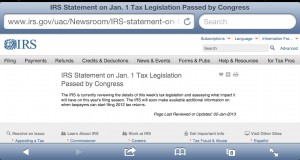The American Taxpayer Relief Act of 2012 does the following:
- Tax Rates – For most individuals it extends the lower federal income tax rates that have existed for the last ten years. However, if you make more than $400,000 (or $450,000 for joint filers), your top rate will increase to 39.6%.
- Capital Gain Rates – Again for those under $400,000 things stay the same as in the recent past. For those in the new top bracket, you will be subject to 20% (instead of 15%) for long-term capital gains and qualifying dividends.
 Alternative Minimum Tax (AMT) – If you didn’t pay enough under the “normal” tax system, you may be subject to a separate tax system with its own rates and tougher rules. The Act permanently extends AMT relief by indexing the exemption for inflation in future years. They also retroactively fixed the patch for 2012. This is a big deal to tax accountants as the annual patch created many tax planning headaches.
Alternative Minimum Tax (AMT) – If you didn’t pay enough under the “normal” tax system, you may be subject to a separate tax system with its own rates and tougher rules. The Act permanently extends AMT relief by indexing the exemption for inflation in future years. They also retroactively fixed the patch for 2012. This is a big deal to tax accountants as the annual patch created many tax planning headaches.- Phaseout of Itemized Deductions and Personal Exemptions – Since 2010, personal exemptions and itemized deductions have not been subject to a phaseout or limitation. Beginning in 2013, both will be subject to phaseout beginning at $250,000 ($300,000 for joint filers).
- Others – There are a handful of other provisions and temporary extensions we won’t get into here.
Bottom-line, if make less than $250,000 ($300,000 for joint filers) your tax situation will not be dramatically impacted either way (a few caveats though, your payroll taxes will go up as the Payroll Tax Holiday of 2% was not extended and some of the provisions of ObamaCare go into effect which could impact you). For the top earners out there making more than $250,000 ($300,000 for joint filers), you will definitely see your taxes climb on a several fronts.
